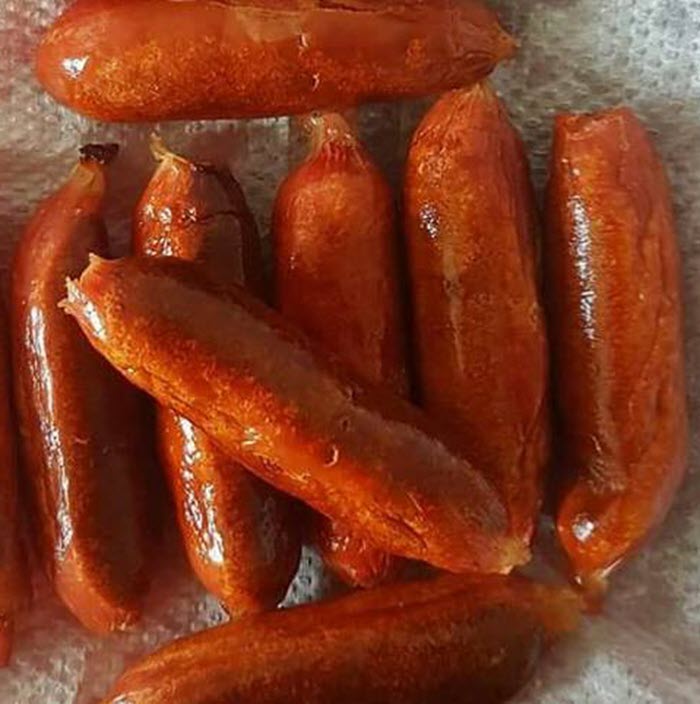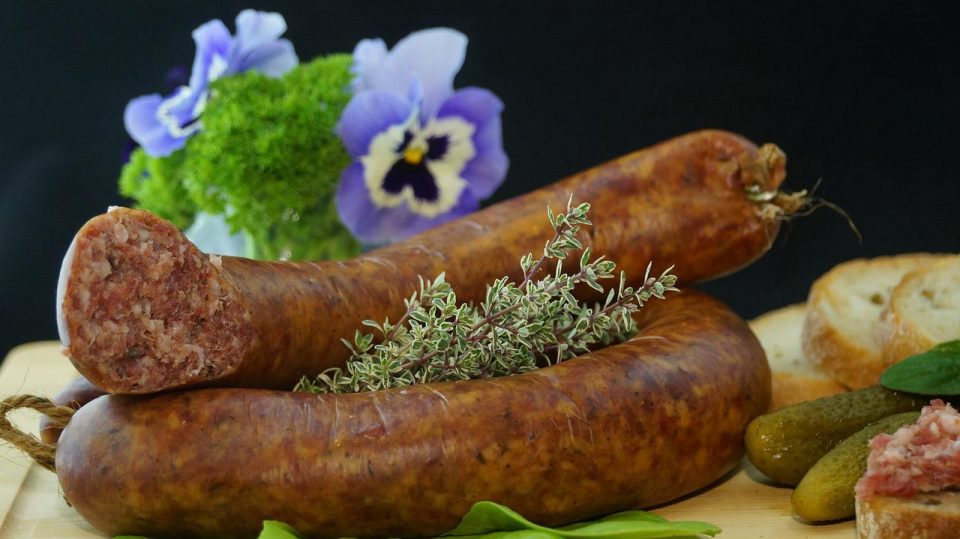How To Tell If Sausage Is Cooked Without Thermometer: A Comprehensive Guide
Have you ever wondered how to tell if sausage is cooked without a thermometer? Cooking sausages to perfection can be a challenge, especially if you don’t have access to precise tools like a meat thermometer. Whether you're grilling, frying, or baking, ensuring your sausages are safe to eat is crucial for health and taste. This article will guide you through the process step by step, ensuring you can enjoy delicious and safe sausages every time.
In today's fast-paced world, convenience often takes precedence over precision. While thermometers are excellent for ensuring food safety, many home cooks may not always have one on hand. This guide aims to provide practical tips and tricks so you can confidently cook sausages without relying on specialized equipment.
By the end of this article, you’ll have a solid understanding of how to tell if sausage is cooked without a thermometer. We’ll cover various cooking methods, visual cues, texture checks, and safety guidelines to ensure your meals are both delicious and safe. Let’s dive in!
Read also:Brett Heggie The Rising Star In The World Of Sports And Entertainment
Table of Contents
- Introduction
- Why Sausage Safety Matters
- Methods to Check If Sausage Is Cooked Without Thermometer
- Visual Indicators of Cooked Sausage
- Texture and Feel: The Tactile Test
- Cooking Methods for Perfect Sausages
- Grilling Tips for Sausages
- Baking Sausages Without a Thermometer
- Frying Sausages: The Best Techniques
- Common Mistakes to Avoid
- Safety Guidelines for Cooking Sausages
- Conclusion
Why Sausage Safety Matters
Sausages are a beloved food item enjoyed by millions worldwide. However, they also pose a significant risk if not cooked properly. Raw or undercooked sausages can harbor harmful bacteria such as Salmonella, E. coli, and Listeria, which can lead to severe foodborne illnesses.
According to the U.S. Department of Agriculture (USDA), ground meats, including sausages, should reach an internal temperature of at least 160°F (71°C) to ensure all pathogens are eliminated. While using a thermometer is the most accurate way to measure this, there are alternative methods that can help you achieve the same results.
Methods to Check If Sausage Is Cooked Without Thermometer
Visual Inspection
One of the easiest ways to determine if your sausage is cooked is by observing its appearance. Cooked sausages should have a uniform brown color, with no pink or raw-looking areas. Any visible juices should be clear, not pink or red.
Texture Test
Another reliable method is the texture test. A properly cooked sausage will feel firm but not hard when pressed gently. It should also have a springy quality, bouncing back slightly when touched.
Smell Test
While not as definitive as other methods, the smell test can provide additional clues. Cooked sausages should have a rich, savory aroma. If you detect any off or raw smells, it’s a sign that your sausage may need more cooking time.
Visual Indicators of Cooked Sausage
When cooking sausages, visual indicators are among the first signs to look for. Here are some key points to consider:
Read also:Tampa Car Wraps Transform Your Ride With Style And Protection
- Color Change: The exterior of the sausage should turn a deep brown color, indicating that the surface is fully cooked.
- Uniform Appearance: Ensure there are no visible raw spots or uneven browning.
- Clear Juices: When pierced with a fork or knife, the juices that escape should be clear, not pink or red.
By paying attention to these visual cues, you can confidently assess whether your sausages are ready to serve.
Texture and Feel: The Tactile Test
Texture plays a crucial role in determining if your sausage is cooked. Here’s how you can perform a tactile test:
- Press Gently: Use your fingers or tongs to press the sausage lightly. It should feel firm but not overly hard.
- Check Springiness: A well-cooked sausage will have a slight bounce when pressed, indicating it has retained its moisture.
- Avoid Overcooking: Be cautious not to press too hard, as this can cause the sausage to lose its juices, leading to a dry texture.
Remember, the texture test is subjective and may vary depending on the type of sausage you’re cooking.
Cooking Methods for Perfect Sausages
Grilling
Grilling is one of the most popular methods for cooking sausages. Here’s how you can achieve perfectly grilled sausages without a thermometer:
- Preheat your grill to medium-high heat.
- Place the sausages on the grill and cook for about 10-15 minutes, turning occasionally.
- Look for a deep brown color and clear juices as indicators of doneness.
Frying
Frying sausages is another excellent option. Follow these steps for perfectly fried sausages:
- Heat a skillet over medium heat and add a small amount of oil.
- Add the sausages to the skillet and cook for about 10-15 minutes, turning frequently.
- Check for a golden-brown exterior and firm texture before serving.
Baking
Baking sausages in the oven is a hands-off method that yields consistent results:
- Preheat your oven to 375°F (190°C).
- Place the sausages on a baking sheet and cook for 20-25 minutes.
- Ensure the sausages are evenly browned and firm to the touch.
Grilling Tips for Sausages
Grilling sausages can be a fun and rewarding experience. To ensure success, keep these tips in mind:
- Preheat the Grill: A hot grill ensures the sausages cook evenly and develop a nice crust.
- Prick with a Fork: Gently prick the sausages with a fork to allow steam to escape and prevent splitting.
- Turn Frequently: Rotate the sausages every few minutes to ensure even cooking on all sides.
By following these tips, you’ll be able to grill sausages that are both flavorful and safe to eat.
Baking Sausages Without a Thermometer
Baking sausages is an excellent option for those who prefer a more controlled cooking environment. Here’s how you can bake sausages without a thermometer:
- Preheat your oven to 375°F (190°C).
- Arrange the sausages on a baking sheet, leaving enough space between them for even cooking.
- Bake for 20-25 minutes, checking for a golden-brown exterior and firm texture.
Baking is particularly useful for cooking large batches of sausages, making it ideal for gatherings and parties.
Frying Sausages: The Best Techniques
Frying sausages on the stovetop offers a quick and easy way to achieve delicious results. Here are some best practices:
- Use the Right Oil: Choose an oil with a high smoke point, such as olive oil or vegetable oil, to prevent burning.
- Control the Heat: Cook on medium heat to ensure the sausages cook evenly without burning on the outside.
- Turn Regularly: Rotate the sausages frequently to achieve an even golden-brown color on all sides.
By mastering these techniques, you’ll be able to fry sausages that are both flavorful and safe to eat.
Common Mistakes to Avoid
Even experienced cooks can make mistakes when cooking sausages. Here are some common pitfalls to watch out for:
- Cooking Too Quickly: Rushing the cooking process can lead to undercooked sausages or a tough exterior.
- Overcrowding the Pan: Cooking too many sausages at once can cause uneven cooking and prevent proper browning.
- Not Turning Frequently: Failing to rotate the sausages regularly can result in uneven cooking and an unappealing appearance.
Avoiding these mistakes will help you achieve consistently great results every time you cook sausages.
Safety Guidelines for Cooking Sausages
Food safety should always be a top priority when cooking sausages. Here are some essential guidelines to follow:
- Store Properly: Keep raw sausages refrigerated until ready to cook, and discard any that have been left out for more than two hours.
- Avoid Cross-Contamination: Use separate utensils and cutting boards for raw and cooked sausages to prevent the spread of bacteria.
- Cook Thoroughly: Ensure sausages are cooked to an internal temperature of 160°F (71°C) to eliminate any harmful pathogens.
By adhering to these safety guidelines, you can enjoy your sausages with peace of mind.
Conclusion
Cooking sausages without a thermometer is entirely possible with the right techniques and attention to detail. By relying on visual indicators, texture tests, and proper cooking methods, you can ensure your sausages are both safe and delicious. Remember to follow food safety guidelines and avoid common mistakes to achieve the best results.
We encourage you to try out these methods and share your experiences in the comments below. Don’t forget to explore our other articles for more cooking tips and tricks. Happy cooking!


